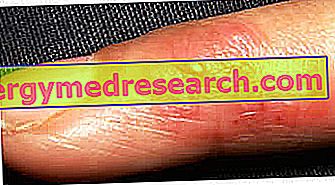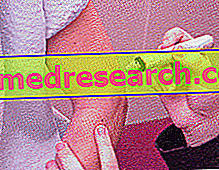Generality
Patereccio is a superficial or subepidermal inflammation that affects the ends of the fingers or toes.
Usually, this inflammatory process is caused by common pyogenic (staphylococci and streptococci) and sometimes by Candida albicans .

Bacterial or fungal agents can penetrate at tissue level through small lesions (splinters, scratches or punctures) and are generally transported with saliva. Once access to the tissues by these microorganisms has taken place, the body's natural defense reaction is to induce a local inflammatory response, which causes a typical symptomatology of inflammatory processes (redness, swelling, heat and pain). In addition, a bacterial and fungal infection can add up at the same time.
The paterecry must not be considered a banal disorder: if neglected it can extend to the deep structures of a finger and also cause serious consequences.
The diagnosis is basically based on the inspection of the affected area. The treatment consists in an adequate therapy with antibiotics or antifungals and can provide for the drainage of any pus.
Types of paterecium
The paterecry is quite common and can affect the superficial or deep structures of a finger.
The inflammatory process is usually acute, but chronic cases also occur.
There are different types of paterecium:
- Superficial patron : it can be simply erythematous in nature or, in the most serious cases, associate with the appearance of an exudate of inflammatory origin that manages to detach the epidermal layers with the production of a flittene (subepidermal vesicle that contains serous or purulent fluid). The superficial paterecium can affect one or more phalanges of a finger and usually evolves within a few hours. In particular, among the different forms it is possible to distinguish the giradita, a condition that surrounds the ring finger and the paronychia, a type of superficial paterecium located near the nail.
- Subcutaneous patellar : the inflammatory process spreads to the periungual and subungual tissues with destruction of the cornea material of the nail.
- Deep paterecry : these are the inflammations that can reach the bone and osteoarticular structures. If neglected and untreated, the tendon sheaths (tenosynovitis) or an articulation between the two phalanges (arthritis) can easily rise, also producing serious alterations of the functionality of the hand or foot.
Causes
The paterecium is often caused by bacteria that are commonly found on the skin, but which manage to penetrate through the skin damaged by a trauma, even as slight as a scratch or a puncture. Biting nails, sucking your finger, washing dishes or using irritating chemicals are behaviors that can increase the risk of getting an infection. In the nails of the hands this pathology is common in subjects who undergo repeated contact with water, solvents or soaps: humidity allows certain microorganisms to proliferate, such as candida or other bacteria.
Apart from the local infection secondary to a trauma, the chronic paterecules can also originate from a systemic disease such as diabetes mellitus or in subjects with a particularly weakened immune system (patients who have undergone organ transplants or are infected with HIV).
Symptoms
To learn more: Symptoms Patereccio
Typically, the paterecule begins with pain, swelling and redness around the base or sides of the nail, at the site of the lesion, especially in the case of bacterial infection. Acute inflammation can lead to the formation of blisters filled with pus (abscesses). The paterecellum caused by bacteria can deteriorate rapidly, while the forms that present Candida albicans infection tend to get worse more slowly. Because of the paterecium alterations of the nails may also occur: they may appear detached, abnormal in shape or have an unusual color.
Diagnosis
The doctor can diagnose the paterecellis with a simple physical examination, simply by observing the irritated skin. Usually, no special investigation is necessary, but the doctor may decide to send a sample of liquid or pus to the laboratory to identify which pathogen is causing the infection. The sample thus taken is subjected to culture examination, with antibiogram to subsequently establish an adequate antibiotic or antifungal therapy.
Complications
Complications are rare, but may include:
- Abscess;
- Continuous changes in the shape of the nail;
- Spread of infection in tendons (tenosynovitis), joints (arthritis), bones (osteitis), entire hand or foot (phlegmon) or blood flow (septicemia).
Rarely, the patron can cause permanent damage to the nail. In cases where very intense inflammation is observed, there is a risk that the infection may spread to deeper tissues, to other areas of the body or to blood circulation (septicemia). In extreme cases of deep infection, the complications of the paternalis can cause painful deformation of the fingers, feet or hands.
You must contact your doctor if:
- Treatment does not help alleviate symptoms.
- The symptoms get worse or new signs appear, such as:
- Local spread of symptoms;
- Development of red streaks through the skin, which extend from the infected area (for example from the fingers to the wrist);
- Feeling of general malaise;
- Temperature;
- Chills;
- Articolar pains;
- Muscular pain.
Treatment
Treatment is generally limited to the removal of the causative agent. In cases of acute paterecious with a bacterial etiology, to help reduce swelling and pain (and accelerate the regression of the infectious process) it could be useful to soak the finger in a mixture consisting of 50% hot water and a 50 % antibacterial liquid soap, 3-4 times a day for about 15 minutes. The doctor may prescribe antibiotics if the paterecellum is caused by bacteria, while it may recommend an antifungal in the home and the infection is determined by a fungus. The fungal paterecry can be difficult to eliminate, so it is necessary to be patient and follow the doctor's recommendations consistently.
In the most serious cases, it is necessary to cut and drain the wound with a sharp instrument: in the presence of an abscess full of pus, the doctor can numb the area, separate the skin from the base or the sides of the nails and drain the purulent material. During the procedure it may be necessary to remove a portion of the nail.
In cases of recurring paterecious, it is important to keep the nails dry and protected from aggressive chemicals. You may need to wear gloves or use a cream that protects your skin from moisture. Furthermore, the application of a topical steroid cream or a solution of ethanol (alcohol) and thymol (fungicide) may be indicated. If the infection does not resolve, be sure to inform your doctor.
See also: Medications for the treatment of Patereccio »
Prognosis
If the condition is treated early, the prognosis is very good. Healing often occurs within a few days. Even the most severe forms of paternal fever usually respond well to treatment. However, mycosis therapy can last up to several months (about 3-6 months before the infection resolves).
Prevention of the patronymic
The best way to avoid the acute paternalis is to take care of the nails:
- Avoid damaging the nails or injuring the fingertips (nails grow slowly and recovery from injury can take months).
- Don't bite your nails.
- Protect your nails from exposure to detergents and chemicals, using protective rubber or plastic gloves, preferably with cotton covers.
- Avoid cutting the nails too short and do not scrape or cut the cuticles, as this can damage the skin. Do not undergo excessively aggressive manicures and pedicures.
- Keep your hands and feet dry the most possible. Dry well after washing.
- Practice proper hygiene and do not share bath towels.
In particular, to minimize the risk of nail damage:
- Keep your fingernails smooth, with a slightly rounded edge and cut them every week, perhaps after a bath, when they are softer.
- Cut toenails (not too short), about once a month.
- Use a pair of sharp scissors for manicure or a specific nail clipper to cut toenails and an emery file to smooth the edges. All tools must be cleaned before and after the procedure.
- Avoid cutting, pulling or tearing the cuticles: removing the cuticles can damage the skin around the nail and help create an entry point for fungi (and bacteria), which can lead to infection.
It is possible to avoid the chronic fever by keeping the skin of the hands and feet dry and free from aggressive chemicals. Change the socks at least every day and do not wear the same shoes for two days in a row, so as to allow them to dry completely.



